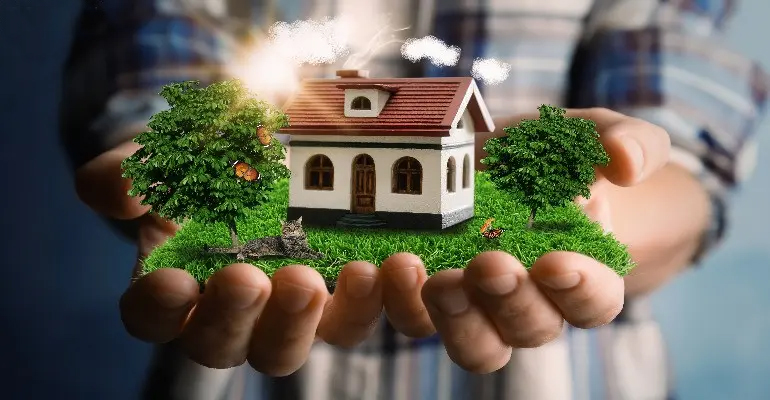Mahesh Ramanujam is the President and CEO of Global Network for Zero (GNFZ), the world’s premiere independent net zero certification body. Mahesh is leading the global decarbonization movement. He is an authority on the intersection of climate, sustainability, business, and financial transformation. Mahesh focuses on digital transformation and measurable climate action.
Benedict Paramanand, Editor of SustainabilityNext, caught up with Mahesh at the recent GNFZ conference on Net Zero Deep Dive Conference in Bengaluru, to demystify concepts and dwell on challenges facing India’s green transition, especially in the real estate sector.
Key Points
- Today, sustainable building can be built below cost
- Major gap in achieving Net Zero is education—both at the business and government level
- Quality of implementation is a challenge in India
- Access to capital and aligning bank financing with green initiatives remains a challenge
- Like incentives for rooftop solar, incentives for green homes are needed
- India needs more dedicated sustainability-focused media, like SustainabilityNext for providing consistent, core-focused messaging
- Building trust and ensuring that sustainability commitments are verifiable and meaningful is key for green transition
Many don’t fully understand the concept of net zero. What are some of the misconceptions you aim to clarify?
Firstly, the definition of net zero itself is unclear. Net zero means that the total of Scope 1, Scope 2, and Scope 3 emissions are reduced or offset to reach zero. The primary focus is on carbon mitigation strategies, with offsetting as a secondary approach.
For example, a net zero building, product, process, city, or business is one that reduces its cumulative Scope 1, Scope 2, and Scope 3 emissions to zero—either through direct carbon reduction strategies or by using carbon offsets to compensate for any remaining emissions. In simple terms, Scope 1 + Scope 2 + Scope 3 emissions should equal zero.

You said that net zero is a long-term journey. How long are we talking about?
The journey depends on the scale. For example, making an entire city like Bangalore net zero could take 10, 15, or even 40 years. However, as per the Paris Climate Agreement, we need to achieve net zero by 2050. That gives us a 25-year window, but for older cities and infrastructure, the transition could take longer.
So, managing this long-term goal requires institutionalizing the process?
Exactly. It needs to be a core part of a business or city’s operational framework. Organizations must integrate emissions assessments, have a well-structured plan aligned with their business strategy, and consistently communicate their progress, challenges, and evolving strategies. Changes in regulations, business models, and technology must be factored in continuously.
Breaking it down into short- and medium-term goals also helps. Does third-party validation play a role in this?
Absolutely. Third-party validation is crucial because this industry has a significant trust deficit. Since definitions and standards are constantly evolving, independent verification strengthens credibility. Just like financial audits, carbon accounting should also undergo third-party verification to ensure transparency and accountability.
That’s a great point. Transparency and practicality in communicating these efforts are key…
Precisely. It’s all about building trust and ensuring that sustainability commitments are verifiable and meaningful.
From a consumer perspective, how would you define a sustainable building?
A sustainable building is one that prioritizes energy efficiency, uses renewable resources, ensures good indoor air quality, and provides a well-lit, ventilated space that enhances occupant well-being. It is not just a concrete structure but an environment that actively contributes to health and sustainability.
Do banks in India have the capability to assess and provide green financing?
Banks create financial products, but they rely on third-party certification agencies like us to validate them. For example, the IFC program is validated by third-party certifiers.
Banks prefer to have an independent party do the validation. However, they are happy to incorporate programs and direct borrowers to meet certain certification requirements. Just like when you take a car loan, the bank asks for insurance papers, banks will require third-party certifications to ensure funds are used appropriately.
Looking at a five-year horizon, what are gaps you see that need to be filled?
The first major gap is education—both at the business and government level. We have a national net-zero goal for 2070, but translating that into every layer of society and regulation is crucial. For instance, when issuing a factory permit, authorities should ask whether the factory is being built to net-zero standards.
The second gap is implementation. While implementation is happening in India, the question is about quality. Are these projects meeting high standards? Can they be replicated? Will they stand the test of time?
The third key aspect is funding. Who will pay for this transition? Businesses need to either secure investments, generate operational savings, or make capital investments for long-term savings. However, access to capital and aligning bank financing with green initiatives remains a challenge.
Isn’t there a way to build sustainable buildings without additional costs?
Absolutely. Today, you can build a sustainable building at cost or even below cost. That’s a powerful message. The economic benefits are clear, with operational cost savings adding directly to the bottom line.
If the business case is strong, why does the perception of higher costs persist?
The issue is often a lack of data and communication. Developers might fear that if they openly discuss cost savings, tenants will demand lower rents. Conversely, they also want to use sustainability as a premium feature to charge more. However, if we focus purely on cost-benefit analysis, green buildings clearly offer long-term financial advantages.
How can we scale this awareness to reach a wider audience?
Currently, if our messaging reaches 40,000 people, we need to scale that to 4 million or even 40 million. If even 10% of decision-makers act on this information, it creates a network effect. Media and publications like yours play a crucial role in driving the sustainability movement.
In India, sustainability content seems scattered across different media outlets. How do you see that evolving?
Yes, many large publications have small ESG or sustainability sections, but they also cover other topics like politics and finance. This creates fragmentation. Dedicated sustainability-focused media, like yours, have a crucial role in providing consistent, core-focused messaging.
How do we take this (sustainable housing) movement into affordable housing?
The only way is through government policies and financial incentives. For instance, the Prime Minister’s initiatives, like the rooftop solar program, explicitly promotes clean energy. If similar mandates are introduced for housing—ensuring every new home meets green standards with corresponding incentives, it would drive adoption.
Would this policy shift also put pressure on cement and steel industries to produce greener materials?
Yes, demand drives change. If policies mandate sustainable housing, there will be demand for green cement, green steel, and other eco-friendly materials. Strong policies will create this demand, and incentives will encourage people to participate. Over time, the entire supply chain will adapt, from green cement and steel to green glass and paint.
Green paint is already emerging, right?
Yes, green paint is essentially low or no volatile organic compound (VOC) paint, meaning it has no toxins, no harmful off-gassing, and is safe for children and adults.
Listen to the Podcast of the interview
https://drive.google.com/file/d/1mxMfgv8WZH3H680z5wgyjbUsZTjQXK4a/view











